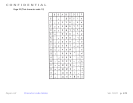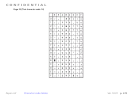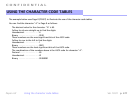
CONFIDENTIAL
Paper roll Using bit value tables
Ver. 10.01 p. 678
Using bit value tables
For each command that has a complex method of determining the variable
n
, there is a table showing how to calculate the
variable in three numbering systems: binary, hexadecimal, and decimal.
When you look at the table, first find the value of each component of the variable. Then add the values of the components
together to determine the value of the variable
n
.
For example, here is how you would use the table below, which selects the print mode, to combine double-height, double-
width, and underline. In the table, you see that bit 4 on (or hex 10 or decimal 16) turns on double-height, bit 5 on (or hex 20
or decimal 32) turns on double-width, and bit 7 on (or hex 80 or decimal 128) turns on underline mode.
To combine all three, turn on bits 4, 5, and 7, which is 10110000 in binary. Or you can add the hex values 10, 20, and 80 for the
hex sum of B0, or you can add the decimal values 16, 32, and 128 for the decimal value of 176.
Therefore, you send the following to turn on double-height, double-width, and underline, depending on the numbering
system used:
ASCII ESC !
n
Hex 1B 21 B0
Decimal 2833176
USING BIT VALUE TABLES


















